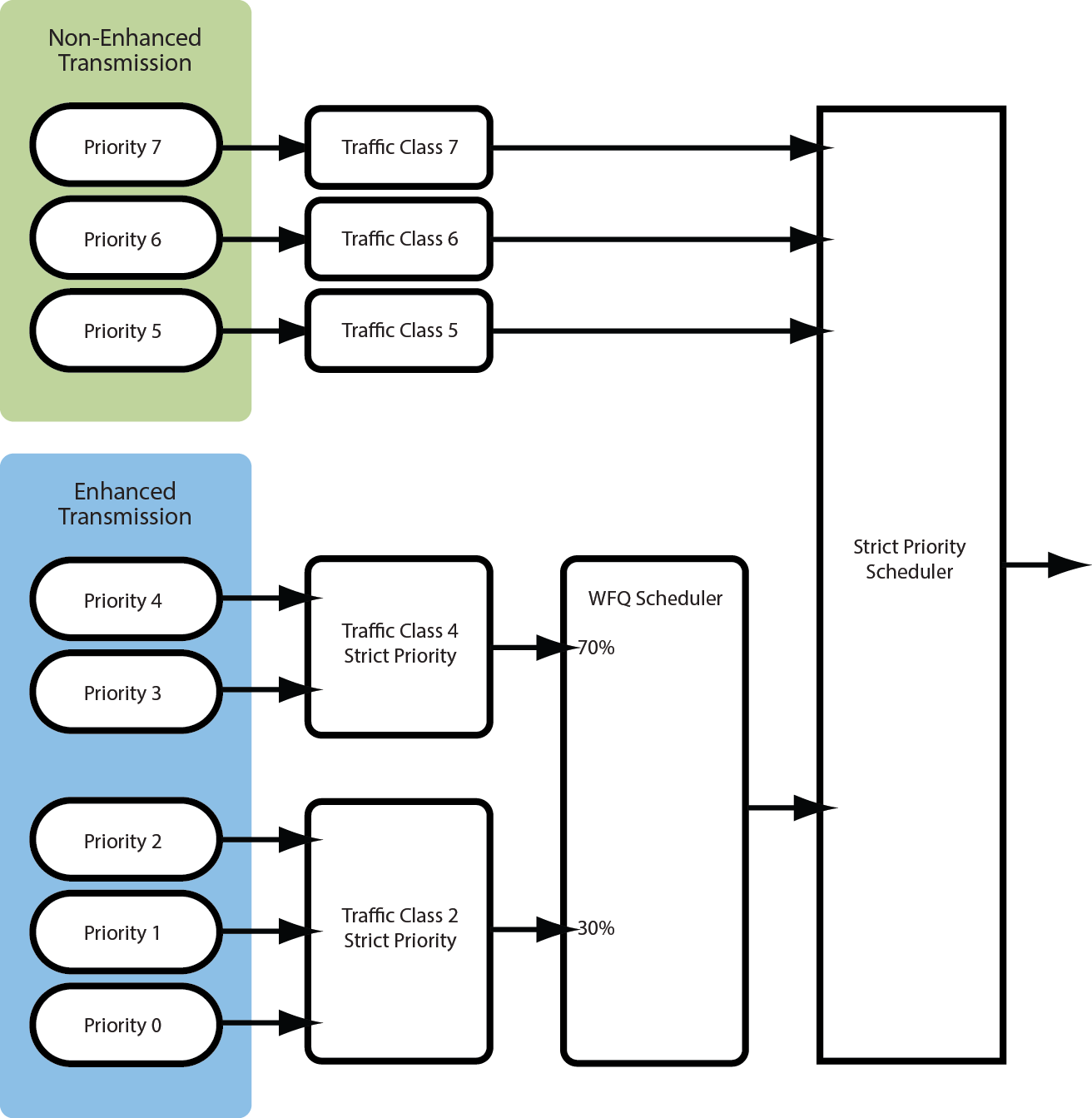Enhanced Transmission Selection (ETS) queuing provides for configuring two or more traffic class queues (transmit queue (TxQ)) to be allocated for bandwidth that will not be serviced until all non-ETS queues are empty. The firmware services non-ETS selection queues first using strict priority, based upon the priority assigned to the queue. Enhanced Transmission Selection queue contents are forwarded to a fair queue scheduler on a strict priority basis. The fair queue scheduler distributes the remaining bandwidth, after all non-Enhanced Transmission Selection queues are empty, based upon the bandwidth allocation configured for the Enhanced Transmission Selection queues.

Note
Enhanced Transmission Selection queuing is restricted to configurable queues. S- K- and 7100-Series modules support both configurable and non-configurable queues. Non-configurable queues are Low Latency Queues (LLQ). LLQs are labeled LLQ in the show cos port-config command display. See Low Latency Queuing for LLQ details.Enhanced Transmission Selection traffic classes (TxQs) and bandwidth allocation are configured using the set cos port-config txq command.
Enhanced Transmission Selection (ETS) Queuing presents an Enhanced Transmission Selection queuing example. Priority queues 7, 6, and 5 are assigned traffic classes 7, 6, and 5, respectively. These non-ETS queues are serviced first by the strict priority scheduler based upon priority.

802.1 priorities 0 - 4 are configured for Enhanced Transmission Selection queuing. Priorities 4 and 3 are assigned to traffic class 4. Priorities 0, 1, and 2 are assigned to traffic class 2. If all non-ETS queues are empty and there is remaining bandwidth, traffic classes 4 and 2 will be serviced using weighted fair queue scheduling. Based upon Enhanced Transmission Selection bandwidth allocation, the weighted fair queue scheduler will service traffic class 4 at 70 percent and traffic class 2 at 30 percent of remaining bandwidth. Within each traffic class group (4 and 2 in this example), each priority is serviced based on a strict priority scheduler.

Note
The 7100-Series supports up to two ETS groups (traffic classes).This example shows how to create a CoS transmit queue port group entry named testTxq with a:
The example assigns ETS groups to an 8 queue 7100-Series device or and 11 queue S- K-Series device, followed by allocation of ETS bandwidth to the assigned groups. Using the enhanced-groups option of the set cos port-config txq command, ETS group to queue assignment is:
Using the enhanced-percentage option of the set cos port-config txq command, the assigned ETS bandwidth allocation is:
7100-Series(rw)->set cos port-config txq 2.0 name testTxq enhanced-groups 2,2,2,4,4,0,0,0 enhanced-percentage 0,30,0,70,0,0,0,0 S-K-Series(rw)->set cos port-config txq 2.1 name testTxq enhanced-groups 2,2,2,4,4,0,0,0,0,0,0 enhanced-percentage 0,30,0,70,0,0,0,0
Use the Enhanced Transmission Selection configuration TLV to advertise this ETS configuration to the peer:
System(rw)->set lldp port tx-tlv enhanced-trans-config
Use the Enhanced Transmission Selection recommendation TLV to recommend that the peer use this ETS configuration:
System(rw)->set lldp port tx-tlv enhanced-trans-rec

 Print
this page
Print
this page Email this topic
Email this topic Feedback
Feedback